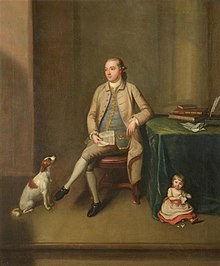
Sir William Gleadowe-Newcomen, 1st Baronet (1741 – 21 August 1807) was an Anglo-Irish politician and banker.
Biography
Born William Gleadowe, he assumed the additional surname and arms of Newcomen following his marriage to Charlotte Newcomen, only child and heiress of Edward Newcomen, on 17 October 1772. On 9 October 1781 he was created a baronet, of Carrickglass in the Baronetage of Ireland.
Gleadowe-Newcomen was elected Company Secretary of the Royal Canal Company at its first meeting (13th November 1789). His involvement in the enterprise is recalled in the naming of Newcomen Bridge which spans the Royal Canal at North Strand and was completed in 1793.
He followed in his father's footsteps as a banker, running a private bank commonly known as Newcomen's Bank. The former bank building is considered to be one of Dublin's finest eighteenth century buildings. It was designed by Thomas Ivory in 1781.
Between 1790 and 1800 Gleadowe-Newcomen was the Member of Parliament for County Longford in the Irish House of Commons. Following the Acts of Union 1800, he represented Longford in the House of Commons of the United Kingdom between 1801 and 1802.
On 29 July 1800 Gleadowe-Newcomen's wife was created Baroness Newcomen in the Peerage of Ireland in honour of her husband, with the remainder to his male heirs. Upon Gleadowe-Newcomen's death in 1807 he was succeeded by his son, Thomas Gleadowe-Newcomen. He also had three daughters, the eldest of whom, Teresa, married Sir Charles Turner of Kirkleatham. William Gleadowe-Newcomen is interred in a family tomb at Drumcondra Churchyard, as is his son Thomas.
References
- ^ Cokayne, George Edward (1900). Complete Baronetage (Volume 5). Exeter: W. Pollard & co., ltd. p. 402.
- Delany, Ruth; Bath, Ian, eds. (2010). Ireland's royal canal: 1789 – 2009. Dublin: Lilliput Press. ISBN 978-1-84351-162-5.
- FUSIO. "Newcomen Bridge and 1st Lock, North Strand Road, Dublin 1, DUBLIN". Buildings of Ireland. Retrieved 25 June 2023.
- "Dublin City Architects Blog — THE FORMER NEWCOMEN BANK (Dublin City Council Rates Office)". Retrieved 25 June 2023.
- FUSIO. "Dublin City Council, 16 Cork Hill, Castle Street/Lord Edward Street, Dublin 2, DUBLIN". Buildings of Ireland. Retrieved 25 June 2023.
- E. M. Johnston-Liik, MPs in Dublin: Companion to History of the Irish Parliament, 1692–1800 (Ulster Historical Foundation, 2006), p. 91 (Retrieved 4 April 2020).
- Garrett, Arthur (1970). From Age to Age, history of the parish of Drumcondra, North Strand, St. Barnabas. Dublin: Parish of Drumcondra, North Strand and St. Barnabas. p. 60.
| Parliament of Ireland | ||
|---|---|---|
| Preceded byHenry Gore Laurence Harman Harman |
Member of Parliament for County Longford 1790–1800 With: Laurence Harman Harman (1790–1793) Caleb Barnes Harman (1793–1796) Sir Thomas Fetherston, Bt (1796–1800) |
Parliament of Ireland abolished |
| Parliament of the United Kingdom | ||
| New constituency | Member of Parliament for Longford 1801–1802 With: Sir Thomas Fetherston, Bt |
Succeeded byHon. Thomas Gleadowe-Newcomen Sir Thomas Fetherston, Bt |
| Baronetage of Ireland | ||
| New creation | Baronet (of Carrickglass) 1781–1807 |
Succeeded byThomas Gleadowe-Newcomen |
- 1741 births
- 1807 deaths
- 18th-century Anglo-Irish people
- 19th-century Anglo-Irish people
- Irish MPs 1790–1797
- Irish MPs 1798–1800
- Baronets in the Baronetage of Ireland
- Members of the Parliament of Ireland (pre-1801) for County Longford constituencies
- Members of the Parliament of the United Kingdom for County Longford constituencies (1801–1922)
- Newcomen family
- UK MPs 1801–1802